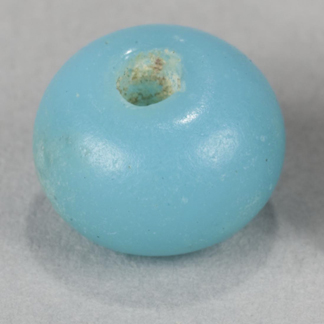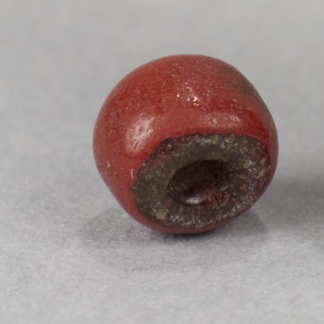Glass beads - while machine-made and ubiquitous today - were once very valuable trade items to people in the Lake Clark region. These tiny colorful objects, when found in historic archaeological sites, can tell us many things including the approximate dates of an archeological site's occupation, the preferences of the past occupants, and who they traded with. The beads featured in this month's blog were all found in the historic Dena'ina Athabascan village of Kijik on the shores of Lake Clark, which is now both a National Historic Landmark and an Archaeological District. The presence of both early and late bead types suggest that the acquisition of trade goods began in the late eighteenth century and continued throughout the occupation of the site, which was abandoned circa 1910.
Glass beads came to Alaska soon after European contact, and were traded with native Alaskans for a variety of things; they were used as currency. The Dena'ina, like many other native Alaskan groups, quickly adopted beads and used them for jewelry, dress, and ornamentation. Before beadwork, the dominate object used for elaborate and intricate designs were porcupine quills. Beads co-existed with quillwork for a time, but because beads were easier to work with and came in a variety of deep colors, they almost completely replaced porcupine quills.
Over the years, more than 1.200 glass trade beads have been discovered in Kijik. The village, whose name means "A Place Where People Gathered," never housed its own trading post; instead the residents received European goods like glass beads through trade with other Native villages, through their travels to trading posts in places like Iliamna, or via the rare group of traveling Europeans that came through Lake Clark. Below are some high lights of beads found at Kijik since the area became a National Park and Preserve in 1980.

The largest bead in the collection is a light blue wound bead of the variety sometimes referred to as "Cook Type.' It is 9mm in diameter and 6.6 mm in height. This type of bead was common during the Russian period all the way through the American period (1741 - post 1867). Smaller blue wound beads like this one were more common during the early Russian period in Alaska (1741-1840). Later wound beads were larger than this one. However, it would be hard to say this is the exact time period this particular bead was from. This type was more likely to be made by hand or just a small outfit (as opposed to the potentially mass produced drawn beads. Technology-wise, a wound bead is a very early type of bead - the glass would be heated until it is workable, and then wound around a metal wire.

Another type of bead from Kijik with a potentially early connotation is the Cornaline d'Aleppo bead type. These are also commonly known as "Hudson Bay beads" or "white heart beads." Despite their name, they were most likely made in Venice. Two of these compound drawn beads were recovered, both with a clear outer layer over a brick red middle layer and a greenish translucent center. Researchers have concluded that earlier Cornaline d'Aleppos tend to have greenish or clear centers, like the Kijik beads, while a white-centered variety (this is where the name "white heart beads" come s from) appear in Alaska mainly after about 1840. There were some of these found at Kijik as well. However, green and clear centered Cornaline d'Aleppos like the one pictured here, do not disappear in later collections, so while their presence at Kijik does suggest they date earlier than 1840, it is not a fool-proof indicator of an early occupation. These are drawn beads - the hated glass is pulled is such a way that a bubble forms in the center of the strand - this bubble becomes the hole in the bead.

Some of the other beads found in Kijik definitely represent post-1840 occupation. Seed beads - named for their small uniform shape - are less than 2mm in diameter. They are rarely found in Alaska before 1840. The seed beads pictured here from Kijik are both white, and both drawn beads. These two particular seed beads were found inside the hole in a larger bead - a surprise for the archeologists when they go back to the lab!

Other beads shown here that were found at Kijik include a drawn bead of translucent red glass, a drawn bead of light blue glass, and a small ovoid wound bead of blue glass. All of these date from the late eighteenth century to the early twentieth century in Alaska.
While many beads have been found, it is wise to know the assemblage is still small - we have much to learn yet from Kijik.
